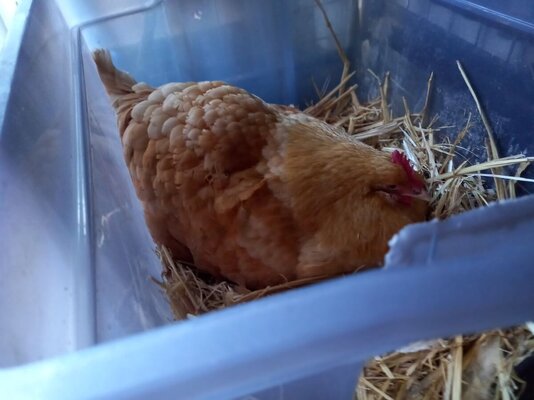Bluebelle7
Chirping
- Sep 21, 2023
- 31
- 56
- 76
I never thought I wanted to do this; all I wanted was 2 more D'Uccle bantams to make up my Bantam flock. But I bought dozen of eggs and put them under our Saffron.
In this moment I only have 2 Bantams, and when one goes broody, the other is all alone at night. I also have 5 big girls, they mingle with the Bantams in the daytime, but have separate coop. So, when Saffron got clucky, I thought I will just pop some day old chicks under her. I did see heaps of ads for day old, while I was looking for POL (too early here). Of course, the moment I started to contact people, they were already gone, some at $35 each - NOT sexed! After few days contacting breeders, one told me his one day chicks are now pre-ordered, but suggested I get dozen of eggs. So i drove to the other side of our city, I collected dozen; 1/2 Millefleur, and half Porcelain. Saffron immediately started cooing at them as I put them in front of her, and gently pushed them under her. That was 27th September, 2 days ago. So far so good.
I know broody hens go without food and water for days, but I have not seen her out since Sunday (Today is Friday), so I took her out. She immediately went for the feeders and had a good drink, then had a good dusting, settled herself in the sun, and showed no intention to go back. I left her for about 10 minutes, then I panicked, and put her back. She jumped in her nest and settled in immediately. How long is OK for broody to have a break?
In this moment Saffron is in the big girls' coop, with water and food (which she does not touch), with puppy pen blocking the other hens. Saffron's bestie tried to sleep in the nest, and I had to evict her. I am constructing temporally coop where the babies can go once hatched. I also have a poultry heat lamp, which I got some years ago for my puppies, so they will be fine if Saffron decides she does not want to raise them. I am also considering the possibility that if one of my other girls starts to be broody, I could give her some of the eggs, and that way if Saffron gives up too early, the other girl could take over the whole lot.
The next thing will be candling; any hints what is the best way, and what I am looking for?
Any advice on the whole process will be much appreciated.
In this moment I only have 2 Bantams, and when one goes broody, the other is all alone at night. I also have 5 big girls, they mingle with the Bantams in the daytime, but have separate coop. So, when Saffron got clucky, I thought I will just pop some day old chicks under her. I did see heaps of ads for day old, while I was looking for POL (too early here). Of course, the moment I started to contact people, they were already gone, some at $35 each - NOT sexed! After few days contacting breeders, one told me his one day chicks are now pre-ordered, but suggested I get dozen of eggs. So i drove to the other side of our city, I collected dozen; 1/2 Millefleur, and half Porcelain. Saffron immediately started cooing at them as I put them in front of her, and gently pushed them under her. That was 27th September, 2 days ago. So far so good.
I know broody hens go without food and water for days, but I have not seen her out since Sunday (Today is Friday), so I took her out. She immediately went for the feeders and had a good drink, then had a good dusting, settled herself in the sun, and showed no intention to go back. I left her for about 10 minutes, then I panicked, and put her back. She jumped in her nest and settled in immediately. How long is OK for broody to have a break?
In this moment Saffron is in the big girls' coop, with water and food (which she does not touch), with puppy pen blocking the other hens. Saffron's bestie tried to sleep in the nest, and I had to evict her. I am constructing temporally coop where the babies can go once hatched. I also have a poultry heat lamp, which I got some years ago for my puppies, so they will be fine if Saffron decides she does not want to raise them. I am also considering the possibility that if one of my other girls starts to be broody, I could give her some of the eggs, and that way if Saffron gives up too early, the other girl could take over the whole lot.
The next thing will be candling; any hints what is the best way, and what I am looking for?
Any advice on the whole process will be much appreciated.





